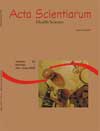<b>Análise comparativa entre os anestésicos locais Articaína 4% e Prilocaína 3% na extração de terceiros molares retidos em humanos</b> - DOI: 10.4025/actascihealthsci.v26i2.1588
Resumo
Os anestésicos locais são as drogas mais utilizadas na Odontologia. São utilizados com freqüência na clínica cirúrgica, sendo de grande ajuda para o cirurgião, visto que a dor tem sido descrita como uma experiência desagradável, tanto em nível sensorial quanto psicológico. O objetivo deste estudo foi adquirir mais conhecimento a respeito da articaína a 4% com adrenalina (Articaine®), além de compará-la clinicamente com a prilocaína 3% com felipressina (Prilonest®). Os anestésicos foram administrados em 21 cirurgias, nas quais, em 8, utilizou-se articaína e, em 13, prilocaína, para remoção de terceiros molares semi-retidos, superior e inferior. Como medicação pré-cirúrgica, foram administradas, uma hora antes, 4 mg de Dexametasona e, no pós-operatório, Dipirona 500 mg, 35 gotas, em caso de necessidade. Foram registrados tempo de latência, duração da cirurgia, duração de efeito do anestésico, efeitos colaterais e quantidade de analgésicos consumidos. Os dados referentes à articaína mostraram-se semelhantes aos encontrados na literatura.Downloads
DECLARAÇÃO DE ORIGINALIDADE E DIREITOS AUTORAIS
Declaro que o presente artigo é original, não tendo sido submetido à publicação em qualquer outro periódico nacional ou internacional, quer seja em parte ou em sua totalidade.
Os direitos autorais pertencem exclusivamente aos autores. Os direitos de licenciamento utilizados pelo periódico é a licença Creative Commons Attribution 4.0 (CC BY 4.0): são permitidos o acompartilhamento (cópia e distribuição do material em qualqer meio ou formato) e adaptação (remix, transformação e criação de material a partir do conteúdo assim licenciado para quaisquer fins, inclusive comerciais.
Recomenda-se a leitura desse link para maiores informações sobre o tema: fornecimento de créditos e referências de forma correta, entre outros detalhes cruciais para uso adequado do material licenciado.























5.png)







